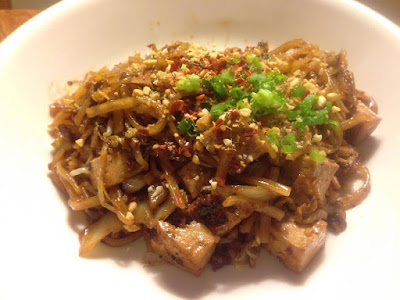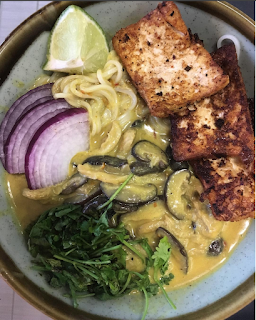Pad Thai
This is the best Pad Thai recipe we've ever tried. Some other recipes either don't really have this richness, or more complicated. So we really recommend you to try this one. The original recipe was taken from New York Times (link below), but we made some adjustment due to ingredients that we couldn't find (or already have something almost similar and didn't really want to buy more), also because we want to keep it vegetarian.
4 ounces fettuccine-width rice stick noodles
¼ cup vegetable oil
1 to 4 tablespoons mixture of lime juice and Indonesian sweet soy sauce
¼ cup soy sauce
⅓ cup honey
2 tablespoons white wine vinegar
½ teaspoon red pepper flakes, or to taste
¼ cup chopped scallions
2 garlic clove, minced
2 eggs
3 cups shredded cabbage
1 cup mung bean sprouts
2 tablespoons white wine vinegar
½ teaspoon red pepper flakes, or to taste
¼ cup chopped scallions
2 garlic clove, minced
2 eggs
3 cups shredded cabbage
1 cup mung bean sprouts
half blocked of pressed extra firm tofu
½ cup roasted peanuts, chopped
½ cup roasted peanuts, chopped
salt to taste
Instruction
1. Put noodles in a large bowl and add boiling water to cover. Let sit until noodles are just tender; check every 5 minutes or so to make sure they do not get too soft. Drain, drizzle with one tablespoon vegetable oil to keep from sticking and set aside. Meanwhile, put 1 tablespoon mixture of lime juice and sweet soy sauce, soy sauce, honey and white wine vinegar in a small saucepan over medium-low heat and bring just to a simmer. Taste and add more mixture of lime juice and sweet soy sauce if desired. It should be piquant, but not unpleasantly sour. Stir in red pepper flakes and set aside.
2. Put remaining 3 tablespoons oil in a large skillet over medium-high heat; when oil shimmers, add scallions and garlic and cook for about a minute. Add eggs to pan; once they begin to set, scramble them until just done. Add cabbage and continue to cook until cabbage begins to wilt, then add tofu.
3. When tofu begins to brown, add drained noodles and bean sprout to pan along with sauce. Toss everything together to coat with tamarind sauce and combine well. When noodles are warmed through, serve, sprinkling each dish with peanuts and garnishing.
Instruction
1. Put noodles in a large bowl and add boiling water to cover. Let sit until noodles are just tender; check every 5 minutes or so to make sure they do not get too soft. Drain, drizzle with one tablespoon vegetable oil to keep from sticking and set aside. Meanwhile, put 1 tablespoon mixture of lime juice and sweet soy sauce, soy sauce, honey and white wine vinegar in a small saucepan over medium-low heat and bring just to a simmer. Taste and add more mixture of lime juice and sweet soy sauce if desired. It should be piquant, but not unpleasantly sour. Stir in red pepper flakes and set aside.
2. Put remaining 3 tablespoons oil in a large skillet over medium-high heat; when oil shimmers, add scallions and garlic and cook for about a minute. Add eggs to pan; once they begin to set, scramble them until just done. Add cabbage and continue to cook until cabbage begins to wilt, then add tofu.
3. When tofu begins to brown, add drained noodles and bean sprout to pan along with sauce. Toss everything together to coat with tamarind sauce and combine well. When noodles are warmed through, serve, sprinkling each dish with peanuts and garnishing.
Link to the New York Times recipe: http://cooking.nytimes.com/recipes/1013121-pad-thai



Comments
Post a Comment